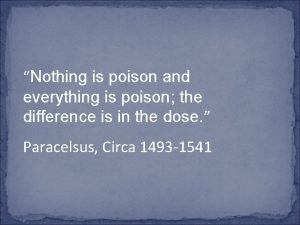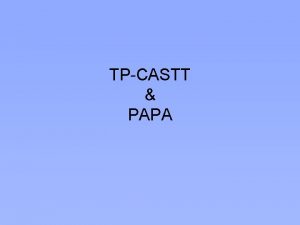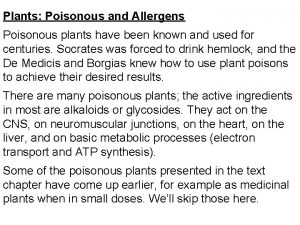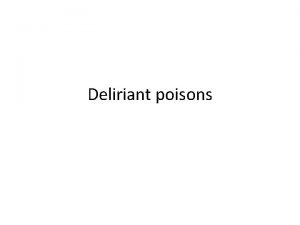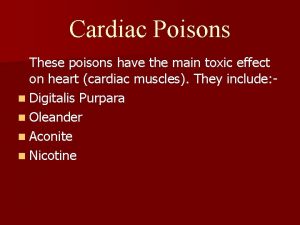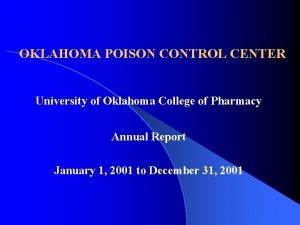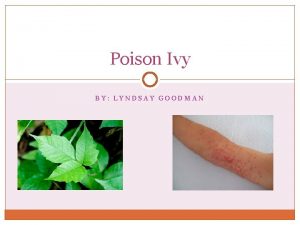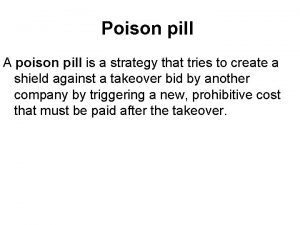Nothing is poison and everything is poison the








































































- Slides: 72

“Nothing is poison and everything is poison; the difference is in the dose. ” Paracelsus, Circa 1493 -1541

Cooking Methods Dry Method: Dry Sautéing, Smoke Roasting, Microwaving, Moist Method: Braising, Stewing, Steaming, Poaching, Pressure Cooking

Flavoring Vegetables Sweet Flavor Vegetables—caramelized onions, ripe tomatoes, yellow turnips Vegetable Mirepoix Flavoring Stalk, Root and Tuber—Often Served Alone Can Be Added to Replace Flavors Lost by Reducing Sodium or Fat Peppers for Flavor Mushrooms

Other Flavorings Vegetable Stocks Fond de veau lie Strong Flavored Nut Oils, Olive and Sesame Flavored Oils Butter and Margarine Compound Butters Acid Products-Basic Taste May Eliminate Salt Flavored Vinegars

Legumes Seeds That Grow in Pods Higher In Protein Than Grains and Good Source of Soluble Fiber. Can be Purchased Fresh or Dried Preparation Fresh—Cook Like a Vegetable Dried—Soak and Cook

Legumes Seeds That Grow in Pods Higher In Protein Than Grains and Good Source of Soluble Fiber. Can be Purchased Fresh or Dried Preparation Fresh—Cook Like a Vegetable Dried—Soak and Cook

Low Fat Cooking Protein Selection Red Meats—leaner Cuts Poultry—Leave Skin On White Meat Leaner than Dark Meat Duck with Skin, Goose High Fat Meat Fish Lean Flat Fish High Fat Fish with Omega 3 FFA

Cooking Low Fat Sauces Lied Sauces with Stock and Cornstarch/Arrowroot Reductions Coulis, Chutneys, Salsas, Purees Fat Replacements Fruit Purees Evaporated Skim Milk Fat Free Yogurt, Ricotta, Cream Cheese Man-made Substitutes Simplese, Olean Substituting One Fat For Another—NOT

Fat Substitutes Fruit Dairy Sweets Prunes Squash and other vegetables Reduced fat butter

Choosing Fat Substitutes Look at recipe’s ingredients. If already contains applesauce, fruit puree, buttermilk, yogurt, increase as fat reduced. If not logical fat substitute, look for blends as applesauce, mashed bananas, cooked squash in spicy recipes; subtle flavors of mild-tasting yogurt, buttermilk in biscuits, scones.

Guidelines for Choosing Fat Substitutes Some recipes better for fat substitution than others: Quick breads, muffins easily adaptable. Coffee, chocolate, carrot cakes with denser textures also translate. Cakes with very light, tender texture harder. May still eliminate ½ - ¾ fat.

Guidelines for Choosing Fat Substitutes In cookies, fruit purees, nonfat buttermilk and yogurt, mashed squash can replace ½ fat, while liquid sweeteners, prune puree, prune butter can replace ALL the fat. Cookies easiest to adapt when they do not already contain significant amounts of liquid ingredients, like applesauce, mashed banana, buttermilk; become cakey or rubbery.

Guidelines for Using Fat Substitutes Cakes made with butter or solid shortening get volume from air when fat creamed with sugar. When fat eliminated, compact. Whip egg whites, gently fold into cake batter. Instead of creaming fat substitute with sugar, add along with other liquid ingredients.

Guidelines for Using Fat Substitutes • Substitute whole grain flour for at least 1/3 to ½ refined flour • Fiber will help maintain pleasing texture. • If final recipe too dry, add 1 -2 T lecithin granules to recipes. • Lecithin is by-product of soy oil refining; greatly improves texture of baked goods. -Granules = 6 g fat/T; liquid = 12 g/T. -Use ½ as much if liquid form.

Guidelines for Using Fat Substitutes • Use coconut sparingly to retain flavor: -Use coconut “water” instead of “milk”; -Sprinkle fresh coconut over top, around edges; -Add coconut-flavored extract • Can use shredded roasted parsnip for shredded coconut • Use soy buttermilk: Add 1 teaspoon vinegar or lemon juice to 1 cup soymilk • Use nut milk: Pulverize ¼ cup blanched almonds, macadamia nuts, walnuts, etc. ; blend with 2 cups water until creamy -Contains as much fat as cow’s milk, but mostly unsaturated.

Overview of Fat Substitutes Fruit: puree, applesauce, fruit juice can replace ALL the fat in cakes, muffins, quick breads, scones, brownies, and HALF the fat in cookies Dairy: nonfat yogurt, buttermilk can replace ALL the fat in cakes, muffins, quick breads, scones, biscuits and brownies, and HALF the fat in cookies

Overview of Fat Substitutes • Sweets: honey, molasses, jam, corn syrup, chocolate syrup can replace ALL the fat in cakes, muffins, quick breads, scones, biscuits, brownies, cookies, crumb toppings, and sweet crumb crusts • Prunes: prune butter and especially prune puree can replace ALL the fat in cakes, muffins, quick breads, scones, brownies, cookies, and sweet crumb crusts

Overview of Fat Substitutes Squash and Sweet Potatoes: can replace ALL of the fat in cakes, quick breads, muffins, biscuits, scones, brownies, and AT LEAST HALF the fat in cookies Reduced-fat butter: can cut the fat in biscuits, scones, cakes, muffins, quick breads, cookies, brownies, pie crusts, and crumb toppings BY MORE THAN HALF

Egg Equivalents • • • Whole, raw, 1 extra large - 247 mg. cholesterol Whole, raw, 1 large - 213 mg. Whole, raw, 1 medium - 187 mg. Egg yolk, raw, 1 large - 213 mg. Egg white, raw, 1 large - 0 mg. Egg substitute, liquid, 1/4 cup - 1 mg. 1 large egg = 1½ egg whites 1 large egg = 3 T. egg substitute 1 large egg white = 2 T. egg substitute

Fat Substitutes: Fruit Use applesauce in gingerbread, chocolate cake, white cake, and in recipes to preserve original flavor Use mashed bananas in muffins, quick breads, chocolate cake Use apple, orange juice in carrot cake Use pureed pears in quick breads, coffee cakes Use pureed peaches in muffins, spice cakes

Basic Guidelines for Using Fruit Replace ALL or part butter or solid shortening in cake, muffin, quick bread recipes with HALF as much fruit “replacer” Replace ALL or part oil with ¾ fruit replacer Some recipes may require 1: 1 replacement

Basic Guidelines for Using Fruit Reduced number of eggs BY HALF. Substitute one whole egg by using an egg substitute (see previous slide). Reduced fat quick breads and chocolate cakes do O. K. without eggs. Bake muffins at 350 degrees; quick breads at 325350 degrees; do not over bake.

Basic Guidelines for Using Fruit • Replace ALL or part butter, solid shortening in • • • scones and biscuits with ½ as much applesauce or fruit puree. Juices do not work well. If recipes call for oil, use ¾ as much. If dough dry, add more fruit replacer. When eliminating all fat, reduce eggs by half, or use egg substitute. Bake at 375 degrees.

Basic Guidelines for Using Fruit • In brownies, replace ALL or part butter or solid shortening with ½ as much applesauce or fruit puree. • If oil, replace with ¾ as much; often need 1: 1 ratio. • If batter seems dry, add more fruit replacer. • If eliminating all fat, replace each whole egg with 3 T egg substitute. • Bake at 325 degrees. • Remove from oven when edges firm, center almost set.

Basic Guidelines for Using Fruit HALF butter or solid shortening with ½ as much applesauce, In cookies, replace mashed banana or fruit puree. If oil, replace half fat replacer. oil with ¾ as much If more than half fat reduced, cookies may be cakey or rubbery.

Basic Guidelines for Using Fruit Cookies with high proportion oats or oat bran easiest to make fat-reduced. Can replace each whole egg with 3 T egg substitute. Bake at 275 -300 degrees.

Fat Substitutes, Nonfat Buttermilk, Nonfat Yogurt, Skim Milk Replace ALL or part solid fat with ½ as much dairy. Replace ALL or part oil with ¾ as much dairy. Reduce number of eggs by half, or substitute 1 egg white for each whole egg.

Basic Guidelines for Using Fat Reduced Dairy Products Some recipes can eliminate eggs and replace with 2 T egg substitute per egg. Others need 1: 1 substitution. Bake muffins at 350 degrees; quick breads/ cakes at 325 -350 degrees; scones at 375 degrees; brownies at 325 degrees; cookies at 275 -300 degrees.

Fat Substitutes: Sweets pairings: Honey pairs with cookies Maple syrup, molasses pairs with muffins, quick breads, spice cakes Apricot jam pairs with oatmeal cookies Orange juice pairs with fruit crisps

Basic Guidelines for Using Sweets Replace ALL or part solid fat with ¾ liquid sweetener Replace ALL or part oil with = amount liquid sweetener; reduce sugar by amount liquid sweetener added Reduce eggs by half, or substitute 1 egg white for each whole egg to help preserve tenderness.

Basic Guidelines for Using Sweets • In some recipes you may eliminate eggs altogether; replace each whole egg with 2 extra T. water or other liquid. • For cakes, muffins, quick breads, reduce oven by 25 degrees; bake scones at 375 degrees; brownies at 325 degrees; cookies 275 to 300 degrees. • Cookies will have a moist, chewy texture. • For crisper cookie, replace only ½ to ¾ fat with liquid sweetener; bake at 300 -325 degrees.

Basic Guidelines for Using Sweets In making crumb crusts with little fat, mixture should look like moist, loose crumbs and hold together when pinched. Form crust using back of spoon coated with nonstick spray and/or dipped in sugar; pat into shape. Bake at 350 degrees until edges firm; do not over bake.

Basic Guidelines for Using Sweets Icing Lower Fat Options: Dust top of cake with confectioner’s sugar or powdered maple sugar. Top with fruit spread or preserves. Use reduced or nonfat cream cheese, or ricotta with vanilla or almond extract, and honey or maple syrup.

Fat Substitutes: Prune Puree Prune puree: Works as fat substitute in many baked goods; especially good in cookies. Texture similar to cookies made with solid fat. Reduces fat by ½ in recipe. ¼ cup puree = 40 calories ½ c butter = 800 calories; ½ c oil = 960 calories

Fat Substitutes: Prune Butter • Prune butter: • Pronounced fruity flavor • Blends well with chocolate, spiced baked goods • Replace solid fat with = amount prune butter • Replace oil with ¾ as much prune butter • ¼ cup = 160 calories • ¼ c butter = 400 calories • ¼ cup oil = 480 calorie

Fat Substitutes: Prune Puree/Butter • Prune puree and prune butter: • Reduce eggs by half, or substitute 1 egg white for each whole egg • In some recipes for quick breads and chocolate cakes, 1 whole egg = 2 T. prune puree • Bake muffins at 350 degrees; quick breads at 325 -350 degrees; biscuits and scones at 375 degrees; brownies at 325 -350 degrees; cookies at standard temp, baking time; do not over bake.

Fat Substitutes: Prune Puree/Butter Baking with prune puree/ prune butter: Flatten cookies to aid spreading. May have to increase baking soda by 25%. Because there is more sugar in prune butter, use standard oven temperature, baking time.

Fat Substitutes: Pumpkin, Squash and Sweet Potatoes Pumpkin natural fat substitute in pumpkin pie, bread, muffin, cakes Just increase as fat decreases. Squash, sweet potatoes add super-moist texture to baked goods; delicious in spice cakes with pineapple, orange, apple Mild flavor; can be used in biscuits, scones, plain muffins, chocolate cakes, brownies

Fat Substitutes: Pumpkin, Squash and Sweet Potatoes Replace ALL or part solid fat with ¾ pumpkin, sweet potato or squash If oil, use = amounts If batter too dry, add more vegetables. Some need 1: 1 substitution

Fat Substitutes: Pumpkin, Squash and Sweet Potatoes Reduce eggs by half; substitute 1 egg white for each whole egg or 2 T water or liquid To retain moistness, bake muffins at 350 degrees; quick breads and cakes at 325 -350 degrees. ; biscuits at 375 degrees; brownies at 325 degrees; cookies at 275300 degrees.

Fat Substitutes: Pumpkin, Squash and Sweet Potatoes In cookies, replace half solid fat with ½ to ¾ as much vegetables. If you replace more, the cookies may be cakey. If oil: replace half oil with ¾ as much vegetables. Can use oats or oat bran successfully.

Other Ingredients for Reduced Fat Baking • Substitute cake • • flour for all purpose flour for more delicate crumb. Replace lowfat yogurt for more moisture, richness, complexity. Don’t eliminate nuts; toast for deeper flavor; sprinkle. Use cocoa powder; espresso powder for more flavor. Substitute reduced fat, low fat cream or cottage cheese, Neufchatel.

Additional Ingredients for Reduced Fat Baking • Use light brown or brown sugar for increased • • moisture. Use mini chocolate chips; sprinkle rather than use throughout. Increase flavor extracts. Decrease peanut butter; add chopped, dry roasted peanuts on top. Use semi-sweet chocolate rather than milk chocolate.

Additional Suggestions for Reduced Fat Baking Cream butter and sugar until light and airy Decrease amount of cookie dough per recipe. Use lower fat butter; proportions solid fat and oil vary; make adjustments according to previous solid fat and oil guidelines. Make your own butter/oil blends.

Heart Healthy Baking Decreases Fat Typical calories and fat in cookie recipe: 2 cups flour – 800 calories – 4. 5 grams fat 1 cup sugar – 720 calories – 0 grams fat 1 cup butter – 1, 600 calories – 177 grams fat 2 eggs - 150 calories – 10 grams fat

General Tips for Lower Fat Baking • Adjust fat substitute: • • Start with ½ fat in recipe; test if batter is dry. Use lower than standard oven temperature. Use lower than standard baking time. Some items are baked when edges are firm and center is set. Keep baked goods moist and fresh in airtight containers in single layer.


Natural Sweeteners Applesauce, yogurt, pureed prunes, mashed bananas, baby food None substituted for all sugar, fat in recipe without sacrificing some taste, texture, appearance Applesauce, yogurt works best overall Add necessary moistness; won't alter flavor as prunes, bananas

Prune Puree Prune puree flavor pairs with chocolate, spice, carrot cakes Label may state butter and oil or fat replacer Add with liquid ingredients

Prune Puree Prunes naturally high in fiber Prune fiber traps air, as fat does Prune puree contains sorbitol (humectant to counteract dryness), and malic acid (flavor enhancer)

Prune Puree Prep Prune Puree: Combine 1 1/3 cup (8 oz) pitted prunes + 6 T water in food processor = 1 cup Prune Butter: Combine 1 pound prunes with 1 cup hot water

Other Fruit Purees Applesauce: Reduce sugar if sweetened; add with liquid ingredients Apple Butter: Reduce sugar if sweetened; add with liquid ingredients Mashed Bananas: Substitute measure for measure; works well in carrot, banana cakes, muffins

Other Sweeteners Maple Syrup: 3/4 cup maple syrup = 1 cup white sugar Reduce liquid by 3 T Add 1/4 teaspoon baking soda/cup to offset acidity Maple Sugar: 1 cup maple sugar = 1 cup white sugar Add 1/8 teaspoon baking soda/cup

Other Sweeteners Barley Malt Syrup: Used with other sugars (as molasses in gingerbread, bread) Substitute 1 1/3 cups barley malt for 1 cup white sugar Reduce liquid by 1/4 cup Add 1/4 teaspoon baking soda/cup Purchase only 100% barley malt (not barley/corn malt syrup); strong flavor

Other Sweeteners Brown Rice Syrup: Most often combined with maple syrup Substitute 1 1/3 cups for 1 cup white sugar Reduce liquid 1/4 cup per 1 cup rice syrup Add 1/4 teaspoon baking soda/cup

Other Sweeteners Benefits of Other Sweeteners compared to sugar: Use less Little to no effect on blood sugar Better glucose tolerance; diabetes management Better weight control; maintenance

Gluten Intolerance Celiac Disease

Foods Containing Gluten Breading, Broths, Coating Mixes, Communion Wafers, Croutons, Imitation Bacon, Imitation Seafood, Marinades, Pastas, Processed Meats, Roux, Sauces, Self-basting Poultry, Soup Bases, Stuffing, Thickeners

Read Labels Brown Rice Syrup (frequently made from barley) Caramel Color Dextrin (usually corn, but may be from Wheat) Flour or Cereal Products

Labels Hydrolyzed Vegetable Protein (HVP), Vegetable Protein, Hydrolyzed Plant Protein (HPP) or Textured Vegetable Protein (TVP) Malt or Malt Flavorings (usually from Barley) Malt Vinegar

Labels Modified Food Starch or Modified Starch from Unspecified Source Mono & Di-Glycerides Flavorings in Meat Vanilla Soy Sauce Vegetable Gum

Concerns for the Chef Food Preparation The molecules of Gluten are the Problem Cross Contamination is a Problem with utensils (a toaster), cooking surfaces, frying oil Food Manufacturing Foods Prepared with Machinery or Equipment Can Stay Airborne for Many Hours

Gluten Products Gluten Forms the Structure, crumb texture, moisture absorptions and Elasticity of Breads, Quick breads, Cakes and Cookies When not Using Gluten Products, Other Grains can Be Used as Flours. Recipes Have to Be Adjusted. Doughs Will Be Sticky and Gummy Need to Add Extra Leavening, Starches

Solutions If a Lighter End Product Desired Use Higher Ratio of Starchy, Lighter Refined flours. For Denser Crumb Texture, Use Less Starchy Flours and More Grittier Use Xanthan Gum or Guar Gum as Binder Replacement Milk and Eggs May Be altered

Menu Planning Parameters Base Calorie Levels On Customers Average Intake Based On 2000 Calories Daily Values From FDA Teens Would Require More and Seniors Less

Calories Per Meal Period Breakfast-----400 to 500 Lunch-----500 to 600 Dinner-----700 to 800 Snacks-----200 per day Maximum

Portions Decrease Protein Portion Sizes to 3 -4 oz. (raw weight) Give Generous Portions Of Grains, Legumes, Fruits, And Vegetables Serve Two Portions Of The Same Items Artfully Display Food To Preserve Value Perception Measure accurately

Techniques for Plating Stuffing Meat with Vegetables and/or Grains Special Knife Cuts Cutting on Bias Fanning Pounding or Butterflying Giving Height

Recipe Development Use Existing Recipes Change Technique and Cuts Review Types of Food In Recipe Sauces Should Not Add Much Fat Or Salt Garnishes, Flavoring Ingredients and High Salt or High Fat Items Are Measured

Modifying Recipes Adjust for Sodium, Calories, Fat, Cholesterol and Sugar Modify Recipes In Which The Integrity Will Be Maintained Technique and Ingredient Can Be Modified Consider The Function Of The Ingredient And The Flavor It Provides Portion Sizes Can Be Adjusted

Creating Original Recipes Understand The Interaction of Ingredients, Flavor Dynamics, and Nutrition. Adjust Portions and Ingredients Again, Measure Accurately Preferably Using a Gram Scale Write Down The Recipe And Analyze Make It The Standard

Conclusion Understand Techniques Of Preparation Know Flavors Of Food Modify Recipes To Meet The Nutritional Parameters Enjoy A Wonderful Healthy Meal
 Nothing but leaves
Nothing but leaves Everything is poison
Everything is poison To defend everything is to defend nothing
To defend everything is to defend nothing Everything is nothing
Everything is nothing Restful shapes moving
Restful shapes moving Boy does nothing song
Boy does nothing song Etymology and morphology
Etymology and morphology Nothing ___ nothing gained
Nothing ___ nothing gained Hình ảnh bộ gõ cơ thể búng tay
Hình ảnh bộ gõ cơ thể búng tay Lp html
Lp html Bổ thể
Bổ thể Tỉ lệ cơ thể trẻ em
Tỉ lệ cơ thể trẻ em Chó sói
Chó sói Tư thế worm breton là gì
Tư thế worm breton là gì Bài hát chúa yêu trần thế alleluia
Bài hát chúa yêu trần thế alleluia Môn thể thao bắt đầu bằng từ chạy
Môn thể thao bắt đầu bằng từ chạy Thế nào là hệ số cao nhất
Thế nào là hệ số cao nhất Các châu lục và đại dương trên thế giới
Các châu lục và đại dương trên thế giới Cong thức tính động năng
Cong thức tính động năng Trời xanh đây là của chúng ta thể thơ
Trời xanh đây là của chúng ta thể thơ Cách giải mật thư tọa độ
Cách giải mật thư tọa độ 101012 bằng
101012 bằng Phản ứng thế ankan
Phản ứng thế ankan Các châu lục và đại dương trên thế giới
Các châu lục và đại dương trên thế giới Thơ thất ngôn tứ tuyệt đường luật
Thơ thất ngôn tứ tuyệt đường luật Quá trình desamine hóa có thể tạo ra
Quá trình desamine hóa có thể tạo ra Một số thể thơ truyền thống
Một số thể thơ truyền thống Cái miệng xinh xinh thế chỉ nói điều hay thôi
Cái miệng xinh xinh thế chỉ nói điều hay thôi Vẽ hình chiếu vuông góc của vật thể sau
Vẽ hình chiếu vuông góc của vật thể sau Nguyên nhân của sự mỏi cơ sinh 8
Nguyên nhân của sự mỏi cơ sinh 8 đặc điểm cơ thể của người tối cổ
đặc điểm cơ thể của người tối cổ Ví dụ giọng cùng tên
Ví dụ giọng cùng tên Vẽ hình chiếu đứng bằng cạnh của vật thể
Vẽ hình chiếu đứng bằng cạnh của vật thể Tia chieu sa te
Tia chieu sa te Thẻ vin
Thẻ vin đại từ thay thế
đại từ thay thế điện thế nghỉ
điện thế nghỉ Tư thế ngồi viết
Tư thế ngồi viết Diễn thế sinh thái là
Diễn thế sinh thái là Các loại đột biến cấu trúc nhiễm sắc thể
Các loại đột biến cấu trúc nhiễm sắc thể Số.nguyên tố
Số.nguyên tố Tư thế ngồi viết
Tư thế ngồi viết Lời thề hippocrates
Lời thề hippocrates Thiếu nhi thế giới liên hoan
Thiếu nhi thế giới liên hoan ưu thế lai là gì
ưu thế lai là gì Khi nào hổ mẹ dạy hổ con săn mồi
Khi nào hổ mẹ dạy hổ con săn mồi Khi nào hổ mẹ dạy hổ con săn mồi
Khi nào hổ mẹ dạy hổ con săn mồi Sơ đồ cơ thể người
Sơ đồ cơ thể người Từ ngữ thể hiện lòng nhân hậu
Từ ngữ thể hiện lòng nhân hậu Thế nào là mạng điện lắp đặt kiểu nổi
Thế nào là mạng điện lắp đặt kiểu nổi What is the answer to life the universe and everything
What is the answer to life the universe and everything Anything that occupy space and has mass
Anything that occupy space and has mass Everything which surrounds us referred as
Everything which surrounds us referred as Everything that lives and moves about will be food for you
Everything that lives and moves about will be food for you What is anything that has mass and volume called
What is anything that has mass and volume called God saw everything he made and it was good
God saw everything he made and it was good How can brahman be everywhere and in everything
How can brahman be everywhere and in everything Poison control utah
Poison control utah A poison tree meaning
A poison tree meaning A poison tree imagery
A poison tree imagery Adaptation of poison dart frog
Adaptation of poison dart frog Poison hemlock range
Poison hemlock range Venom wallpaper 1920x1080
Venom wallpaper 1920x1080 What is a poison pill defense
What is a poison pill defense Iago jealousy quotes
Iago jealousy quotes Deliriant poison means
Deliriant poison means Cardiac poison name
Cardiac poison name A poison tree theme form 5
A poison tree theme form 5 Poetry terms quiz
Poetry terms quiz Ld 50
Ld 50 Spinal poison
Spinal poison Poison oak adaptations
Poison oak adaptations Poison control oklahoma
Poison control oklahoma

